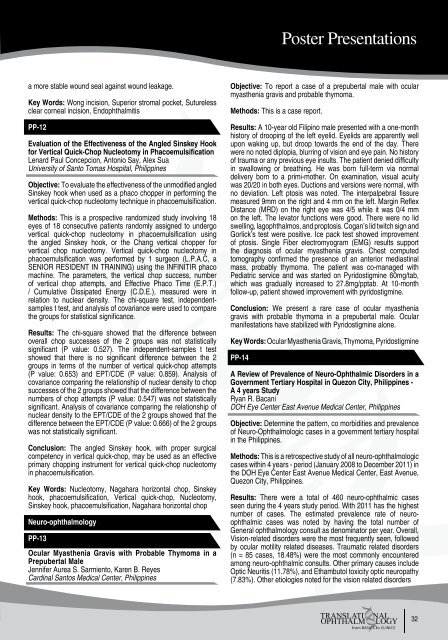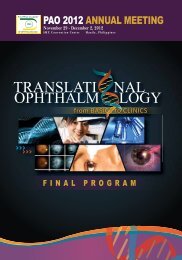Table of Contents - PAO Annual Meeting 2012
Table of Contents - PAO Annual Meeting 2012
Table of Contents - PAO Annual Meeting 2012
You also want an ePaper? Increase the reach of your titles
YUMPU automatically turns print PDFs into web optimized ePapers that Google loves.
a more stable wound seal against wound leakage.<br />
Key Words: Wong incision, Superior stromal pocket, Sutureless<br />
clear corneal incision, Endophthalmitis<br />
PP-12<br />
Evaluation <strong>of</strong> the Effectiveness <strong>of</strong> the Angled Sinskey Hook<br />
for Vertical Quick-Chop Nucleotomy in Phacoemulsification<br />
Lenard Paul Concepcion, Antonio Say, Alex Sua<br />
University <strong>of</strong> Santo Tomas Hospital, Philippines<br />
Objective: To evaluate the effectiveness <strong>of</strong> the unmodified angled<br />
Sinskey hook when used as a phaco chopper in performing the<br />
vertical quick-chop nucleotomy technique in phacoemulsification.<br />
Methods: This is a prospective randomized study involving 18<br />
eyes <strong>of</strong> 18 consecutive patients randomly assigned to undergo<br />
vertical quick-chop nucleotomy in phacoemulsification using<br />
the angled Sinskey hook, or the Chang vertical chopper for<br />
vertical chop nucleotomy. Vertical quick-chop nucleotomy in<br />
phacoemulsification was performed by 1 surgeon (L.P.A.C, a<br />
SENIOR RESIDENT IN TRAINING) using the INFINITIR phaco<br />
machine. The parameters, the vertical chop success, number<br />
<strong>of</strong> vertical chop attempts, and Effective Phaco Time (E.P.T.)<br />
/ Cumulative Dissipated Energy (C.D.E.), measured were in<br />
relation to nuclear density. The chi-square test, independentsamples<br />
t test, and analysis <strong>of</strong> covariance were used to compare<br />
the groups for statistical significance.<br />
Results: The chi-square showed that the difference between<br />
overall chop successes <strong>of</strong> the 2 groups was not statistically<br />
significant (P value: 0.527). The independent-samples t test<br />
showed that there is no significant difference between the 2<br />
groups in terms <strong>of</strong> the number <strong>of</strong> vertical quick-chop attempts<br />
(P value: 0.653) and EPT/CDE (P value: 0.859). Analysis <strong>of</strong><br />
covariance comparing the relationship <strong>of</strong> nuclear density to chop<br />
successes <strong>of</strong> the 2 groups showed that the difference between the<br />
numbers <strong>of</strong> chop attempts (P value: 0.547) was not statistically<br />
significant. Analysis <strong>of</strong> covariance comparing the relationship <strong>of</strong><br />
nuclear density to the EPT/CDE <strong>of</strong> the 2 groups showed that the<br />
difference between the EPT/CDE (P value: 0.666) <strong>of</strong> the 2 groups<br />
was not statistically significant.<br />
Conclusion: The angled Sinskey hook, with proper surgical<br />
competency in vertical quick-chop, may be used as an effective<br />
primary chopping instrument for vertical quick-chop nucleotomy<br />
in phacoemulsification.<br />
Key Words: Nucleotomy, Nagahara horizontal chop, Sinskey<br />
hook, phacoemulsification, Vertical quick-chop, Nucleotomy,<br />
Sinskey hook, phacoemulsification, Nagahara horizontal chop<br />
Neuro-ophthalmology<br />
PP-13<br />
Ocular Myasthenia Gravis with Probable Thymoma in a<br />
Prepubertal Male<br />
Jennifer Aurea S. Sarmiento, Karen B. Reyes<br />
Cardinal Santos Medical Center, Philippines<br />
Objective: To report a case <strong>of</strong> a prepubertal male with ocular<br />
myasthenia gravis and probable thymoma.<br />
Methods: This is a case report.<br />
Results: A 10-year old Filipino male presented with a one-month<br />
history <strong>of</strong> drooping <strong>of</strong> the left eyelid. Eyelids are apparently well<br />
upon waking up, but droop towards the end <strong>of</strong> the day. There<br />
were no noted diplopia, blurring <strong>of</strong> vision and eye pain. No history<br />
<strong>of</strong> trauma or any previous eye insults. The patient denied difficulty<br />
in swallowing or breathing. He was born full-term via normal<br />
delivery born to a primi-mother. On examination, visual acuity<br />
was 20/20 in both eyes. Ductions and versions were normal, with<br />
no deviation. Left ptosis was noted. The interpalpebral fissure<br />
measured 9mm on the right and 4 mm on the left. Margin Reflex<br />
Distance (MRD) on the right eye was 4/5 while it was 0/4 mm<br />
on the left. The levator functions were good. There were no lid<br />
swelling, lagophthalmos, and proptosis. Cogan’s lid twitch sign and<br />
Gorlick’s test were positive. Ice pack test showed improvement<br />
<strong>of</strong> ptosis. Single Fiber electromyogram (EMG) results support<br />
the diagnosis <strong>of</strong> ocular myasthenia gravis. Chest computed<br />
tomography confirmed the presence <strong>of</strong> an anterior mediastinal<br />
mass, probably thymoma. The patient was co-managed with<br />
Pediatric service and was started on Pyridostigmine 60mg/tab,<br />
which was gradually increased to 27.8mg/pptab. At 10-month<br />
follow-up, patient showed improvement with pyridostigmine.<br />
Conclusion: We present a rare case <strong>of</strong> ocular myasthenia<br />
gravis with probable thymoma in a prepubertal male. Ocular<br />
manifestations have stabilized with Pyridostigmine alone.<br />
Key Words: Ocular Myasthenia Gravis, Thymoma, Pyridostigmine<br />
PP-14<br />
Poster Presentations<br />
A Review <strong>of</strong> Prevalence <strong>of</strong> Neuro-Ophthalmic Disorders in a<br />
Government Tertiary Hospital in Quezon City, Philippines -<br />
A 4 years Study<br />
Ryan R. Bacani<br />
DOH Eye Center East Avenue Medical Center, Philippines<br />
Objective: Determine the pattern, co morbidities and prevalence<br />
<strong>of</strong> Neuro-Ophthalmologic cases in a government tertiary hospital<br />
in the Philippines.<br />
Methods: This is a retrospective study <strong>of</strong> all neuro-ophthalmologic<br />
cases within 4 years - period (January 2008 to December 2011) in<br />
the DOH Eye Center East Avenue Medical Center, East Avenue,<br />
Quezon City, Philippines.<br />
Results: There were a total <strong>of</strong> 460 neuro-ophthalmic cases<br />
seen during the 4 years study period. With 2011 has the highest<br />
number <strong>of</strong> cases. The estimated prevalence rate <strong>of</strong> neuroophthalmic<br />
cases was noted by having the total number <strong>of</strong><br />
General ophthalmology consult as denominator per year. Overall,<br />
Vision-related disorders were the most frequently seen, followed<br />
by ocular motility related diseases. Traumatic related disorders<br />
(n = 85 cases, 18.48%) were the most commonly encountered<br />
among neuro-ophthalmic consults. Other primary causes include<br />
Optic Neuritis (11.78%), and Ethambutol toxicity optic neuropathy<br />
(7.83%). Other etiologies noted for the vision related disorders<br />
32



